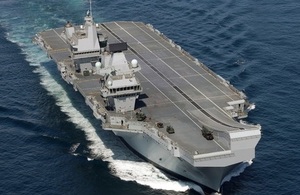How Dstl helped launch the HMS Queen Elizabeth carrier
Dstl analysis has helped to bring Britain’s new flagship carrier HMS Queen Elizabeth into service.

HMS Queen Elizabeth
As the Queen Elizabeth Carrier (QEC) arrives in Portsmouth for the first time, the Defence Science and Technical Laboratory (Dstl) will finally see the results of years of working behind the scenes to ensure safety, efficiency and future-proofing. This includes the jump which launches the new F-35 fast jet – which sits at the bow of the new HMS Queen Elizabeth.
Dstl has been working on the operational analysis for the carrier since the early 1990s – starting formally with the replacement study to look at what came after the Invincible class.
Studies have defined the size and shape of the ship and its important characteristics, including manning and its air wing, right through to sortie generation and the flight deck layout.
In the mid-2000s, a specialist Dstl team looked at ship-air integration. As a result of this, and using their existing knowledge, the ski-jump used to launch the F-35 fighter jets from the deck of the carrier was brought into being.
Requirements of any launch device included the aircraft launch performance to be achieved safely within deck run limitations, the maximum loads to both aircraft and deck and environmental conditions, all within strict ski-jump limitations on height and length.
The resulting requirements were balanced and feasible, and they were subsequently used to design the QEC ski-jump that now sits at the bow of the HMS Queen Elizabeth.
Martin Rosa, Principal Technical Consultant at Dstl, said:
The impact of Dstl’s work is that the UK’s F-35B force will have the ability to launch robustly and safely from the Queen Elizabeth Class carriers with operationally relevant mission loadouts in a wide range of weather conditions around the world, using the minimum of deck run, while minimising stress on both aircraft and ship.
Dstl media enquiries
Email DstlPress@dstl.gov.uk
Press office 01980 950000 option 2